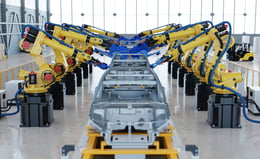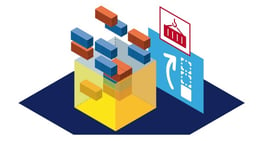The Automaker’s Guide to Demand Capacity Planning
Brian Hoey - July 30, 2019

Let's say you’re a bartender in a sleepy neighborhood pub in your city. Your place might reasonably be called a dive bar, and you have a handful of regulars who come and order basically the same drinks week after week. As a result, your ordering process for restocking the bar is extremely simple. With little variation, you expect to go through predictable quantities of gin, tonic, bourbon, and cheap beer every month, and you’ve simply placed a standing order with the local distribution company to restock these things in the same quantity every so often. Life is pretty easy.
All of a sudden, however, the neighborhood starts to gentrify: your locals are now sitting elbow-to-elbow with hipsters ordering obscure liqueurs and cocktails. Bottles that have sat behind the bar untouched for years are suddenly running low, and many of the usual suspects are languishing as a result. In a word, demand has become volatile—and for the first time in years you need to make changes to your standing order. This is tricky, because these new conditions make your old way of forecasting demand (i.e. expecting the past to repeat itself ad infinitum) obsolete.
For a local watering hole, this isn’t an insurmountable problem—you can probably change your orders comparatively last minute and still have a fully-stocked bar for the weekend rush. But if you’re in a similar position demand-wise while creating more complex products—say, a line of luxury automobiles—things can get hairy pretty quickly. Longer planning cycles and incredibly complex orders put massive amounts of pressure on your demand and capacity planning.
Demand Volatility
The reason we're bring up demand volatility is that it is, in point of fact, a major factor in the modern automotive industry. Consumer demand is harder to predict than ever, which means that OEMs have a harder time than ever predicting which parts to produce for their clients. The result is that when an order comes in and you need to slot production of a particular vehicle into your plans, you can find yourself facing a parts shortages—leading to disruption and delays all around. At the same time, automakers are working with increasingly lean supply chains, meaning that an unexpected spike in demand could produce a situation in which no buffer exists with which to achieve the necessary capacity.
In order to combat this increase in volatility, automakers need to get a lot smarter about their demand capacity planning. This begins by splitting the task into its separate components: you’ll need to find a means of forecasting demand that’s more accurate and can be put into practice over the course of longer planning cycles. At the same time, you'll have to create an infrastructure that makes it possible to match your capacity to your demand, which means gaining increased visibility into your procurement, inventory, and production planning—all with an eye towards building in the flexibility and adaptability to create, process, and track orders efficiently as they come in.
Reimagining S&OP
In order to accomplish the ends that we laid out in the paragraph above, automakers need to reimagine their sales and operations planning (S&OP) for the digital era. Rather than crafting forecasts by hand and letting those forecasts guide short- to mid-term decision making, manufacturers working in such a complex space need to utilize advanced analytics to turn internet of things (IoT) sensor data, order creation information, production plans, market information, and other data into usable predictions. By starting from a position of greater accuracy and assurance when planning out your expected capacity needs for the next, say, six months, you can more effectively integrate with your suppliers in order to stave off any outages of critical parts on their end. As a result, the planning and production cycle is smoothed out, giving you a better window into your real capacity at any given moment.
Getting enough data to power these forecasts will require cross-functional buy-in, but the result will be a closer alignment between expectations and reality. This will reduce disruptions, enabling you to continuing operating without much buffer, and even to lengthen your planning cycle over time. Of course, this will require the implementation of additional planning functions within your organization to bridge the gaps between longer term cycles. This is where something like an S&OE (sales and operations execution) workflow—one that operates on making small adjustments to inventory levels and transport plans on a weekly or monthly basis—could add considerable value. Again, digitization is key here. Why? Because S&OE planners need access to a consistent stream of digital demand information, as well as real-time transport and inventory data.
Lean and Connected Supply Chains
Thus far, we’ve considered ways to mitigate disruption in supply and production chains that have, essentially, been forced to go lean out of necessity. With demand so changeable and profit margins often perilously thin, buffer has lately been thought of as a luxury. Now, however, digitization can be used to turn lean processes into a competitive advantage, rather than an unfortunate constraint. Picture a scenario: a customer places a last minute order when your production flows for the week are already basically finalized. In the pre-Industry 4.0 era, you had a choice of disappointing a customer or disrupting your own flow. Now, with S&OE workflows in tow, you can quickly visualize whether or not you have the parts and the production capacity for the order, and then use digital twins to consider creative ways of slotting the order in.
In this way, increased digitization and connectivity across different touchpoints on the value chain help power a new paradigm in demand capacity planning. Instead of making do with old-school forecasting methods and hoping for the best, you can use intelligent planning to help bring demand expectations (and thus production expectations) more closely in line with reality. When disruptions do arise—as they inevitably will—you’ll have the visibility and the tools to manage them in a way that preserves maximum value. In this way, volatility becomes much less of a concern.
If you want to learn more get your Guide to Sales & Operations Planning
In this Guide you will learn:
-
Why a S&OP Process is important
-
How a S&OP System can be flexible and quickly implemented
-
Central tasks of a S&OP System
-
The key to more productivity
LATEST POSTS
- Understand Circular Economy in The Manufacturing Industry
- How Can Industry 4.0 IT Integration Be Achieved Smoothly?
- The Significance of Order Sequencing in Discrete Manufacturing
- How to improve your Supply Chain Management: The Power of Control Towers
- Optimizing Human Resource Scheduling in Manufacturing: A Technological Approach



